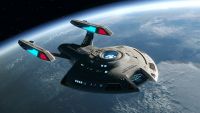Nova Class
| STARSHIP | |
|---|---|
 | |
| Class | Rhode Island Class |
| Allegiance | United Federation of Planets |
Based on the earlier Nova-class, the Rhode Island-class is one of the most advanced ships of her size. Sleek and fast, she is equally capable as a fast exploration platform that can quickly map unknown space and as a tactically-oriented scout that can use her powerful sensor platforms to seek out threat vessels.
Class History
Following the return of the starship Voyager from the Delta Quadrant in 2378, Starfleet studied the upgrades the crew had performed to the ship with great interest, as well as combing over the logs and records from the starship Equinox which demonstrated the incredible survivability of the Nova-class platform. Intent on replicating these upgrades, Starfleet pulled the Nova-class starship Rhode Island out of active service to serve as a technological testbed, in concert with the large Century-class heavy explorer also in the prototyping stage at the time.
Over four years, the Rhode Island was slowly and meticulously upgraded, spending much of her time in the core of the Federation as various upgrades were integrated and perfected. Her sensible, easy-to-maintain warp core was replaced with a miniaturized version of the Intrepid’s Class-9 engine, with improvements made to the warp coils based off of upgrades tested aboard the USS Sovereign. Quantum torpedo launchers were fitted in place of the single-fire photon torpedo tubes and the phaser arrays were upgraded to the latest Type-XII standards. The auxiliary deflector was made smaller to increase the deck space on Decks 3 and 4 to accommodate additional power trunks to power the enhanced tactical equipment and enhanced life support systems for the slightly larger crew needed to maintain them.
While only ever intended to be a one-off prototype for other new designs, the Rhode Island herself was one of the fastest and most advanced ships in the fleet by 2382, all without the trouble of designing a completely new spaceframe. Maintenance was an issue–the advanced systems taxed her crew–but the longer she was in service, the more of these issues became less of a problem. Consequently, Starfleet ordered an initial production run of 60 of these ships in 2383, intending to use them in a number of roles where a fast, well-armed ship with a small profile might be useful.
During the 2380s and 2390s, these ships proved to be equally capable of deep space tactical assignments, scouting missions, and sustained independent exploration, thanks to their new armaments, enhanced speed, and greater endurance compared to the Nova. The Nova remained in production as it had acquitted itself equally-well as an efficient surveyor with a proven design, leading to a rare situation in which two designs based on the exact spaceframe were in production at the same time.
Shipboard Life
With a crew of only ninety-five, life on board a Rhode Island-class ship means knowing everyone on the ship. There is often less of a divide between officers and enlisted personnel than on larger ships, simply because there are fewer communal spaces to allow for such a separation.
Senior officers have individual quarters with a combination living area and bedroom along with a private head. The captain and the executive officer have slightly larger quarters on Deck 1, giving them easy access to the bridge, but these are roughly the same as other officers’ quarters due to the size of the ship. Other officers share quarters with private bedrooms, and enlisted crewmembers have bunk beds in suites housing up to eight people.
There are two observation lounges, two mess halls, a gymnasium, and a recreation area, along with two small holodecks.
Vessels of Note
| Name | Registry | Status |
|---|---|---|
| USS Philadelphia | FSV-66053 | Active |